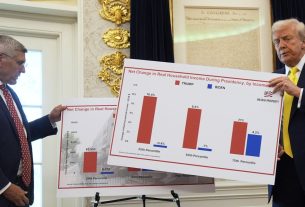U.S. Consumer Confidence Declines as Pessimism Takes Hold
Jerome Powell finally got some good news today: the American people grew increasingly pessimistic about the economy in February.
The Conference Board said its index of consumer confidence decreased to 102.9 from a 106 reading in January. The previous month’s figure was revised down from 107.1.
This was not expected. The strong jobs numbers and retail sales figures for January fanned expectations that consumer confidence would be on the rise. Also, the University of Michigan’s consumer sentiment survey improved, and many expected the Conference Board’s measure to follow suit.
Interestingly, the assessment of the present situation did improve—and precisely for the reason people expected: more jobs. The share of consumers saying jobs are plentiful jumped to 52 percent, up from 48 percent last month, while the share saying jobs are “hard to get” fell to 10.5 percent from 11.1 percent.
This was enough to offset the moderate decline in the assessment in current business conditions, pushing the present situation index up to 152.8 from 151.1 last month. The share saying current business conditions are good declined to 17.8 percent from 19.9 percent, but the share saying conditions are bad also fell from 19 percent 17.7 percent, creating a virtual tie.
Something Wicked This Way Comes
What dragged down the overall index was a serious plunge in the forward-looking expectations index. This declined to 69.7 from 76 at the start of the year. The Conference Board says that readings below 80 often signal a recession is coming in the next 12 months. This has been below 80 in 11 of the past 12 months, so a recession is overdue by this measure.
The labor market outlook showed 14.5 percent of consumers expect more jobs will be available six months from now, down from 17.7 percent in January. The share expecting fewer jobs ticked down to 20.3 percent from 21.4 percent.
It is remarkable that the negative assessment is not much higher. Fed Chairman Powell has been perfectly clear that lowering demand for labor is one of the goals of current monetary policy. Even the most optimistic forecast of how this might work has the number of jobs declining even if outright unemployment stays quite low. More likely, the unemployment rate will have to climb significantly from the current 3.4 percent in order to bring inflation down near the Fed’s two percent target.
(iStock/Getty Images)
The outlook for incomes also became “considerably less upbeat,” in the Conference Board’s phrasing. The share expecting incomes to increase fell from 17.4 percent last month to 13.4 percent. The share expecting incomes to fall, however, also declined from 11.6 percent to 13.4 percent.
Expectations for inflation 12 months from now fell to 6.3 percent from 6.7 percent last month. While that is an improvement, it still suggests that consumers expect inflation will run very high into next year.
The Fed’s Beatings Will Continue Until Morale Improves
Ataman Ozyildirim, the Conference Board’s economist, said in a statement that “consumers may be showing early signs of pulling back spending in the face of high prices and rising interest rates. Fewer consumers are planning to purchase homes or autos and they also appear to be scaling back plans to buy major appliances. Vacation intentions also declined in February.”
Expectations for business conditions were also less hopeful. The share of consumers expecting business conditions to improve fell to 14.2 percent, down from 18.4 percent in January. The share expecting business conditions to worsen slid to 21.9 percent from 22.6 percent. This too looks relatively optimistic given the fact that the masters of monetary policy have declared that they expect taming inflation will require the economy to grow at a rate below its long-term trend for some time.
As we said, this pessimism is good news from the perspective of Powell because it suggests that the Fed’s consistent message that the beatings will continue until inflation improves has taken hold. They keep telling us they intend to worsen economic conditions—and people are listening.
Trade Deficits and Sluggish Inventory Growth Is a Drag on GDP
The economic data continues to send decidedly mixed signals about the pace of economic growth in the first months of this year.
On the one hand, we have the now familiar litany of inflationary boom signals: job growth was explosive, openings soared, retail sales were stronger than anticipated, and inflation was hot. Core durable goods orders came in above expectations, as did orders excluding transportation. Nondefense capital goods shipments ex-aircraft grew by 1.1 percent, a very solid gain.

Cargo ships filled with containers dock at the Port of Los Angeles. (Frederic J. Brown/AFP via Getty Images)
On the other, the trade deficit in goods widened from $89.7 billion to $91.5 billion in January, despite a bigger than expected rise in exports. Imports climbed 3.2 percent, driven by an 8.6 percent increase in automative imports and a 5.6 percent increase in consumer goods. Also, wholesale inventories grew at a more sluggish pace than expected. These should weigh down GDP.
The wide gap in various GDP trackers illustrates just how confusing the signals are. Bank of America‘s data tracker now sees economic growth at just 0.9 percent in the first quarter, down from 1.2 percent prior to the Tuesday data on trade and inventories. The Atlanta Fed’s GDP now tracker, however, has the economy growing at a 2.8 percent rate.



